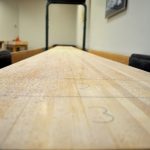
The Differences Between Table Shuffleboard & Ground Shuffleboard
 Have you ever heard people talking about shuffleboard and found yourself hearing mixed messages? Maybe you’ve been invited to a shuffleboard game, only to find a group of people standing around carrying sticks? Table shuffleboard and ground shuffleboard are two popular games with similar ancestry, but very different styles which may confuse anyone who isn’t familiar. To help, we’ve put together some information that describes the biggest differences between the two: the playing fields and how points are handled.
Have you ever heard people talking about shuffleboard and found yourself hearing mixed messages? Maybe you’ve been invited to a shuffleboard game, only to find a group of people standing around carrying sticks? Table shuffleboard and ground shuffleboard are two popular games with similar ancestry, but very different styles which may confuse anyone who isn’t familiar. To help, we’ve put together some information that describes the biggest differences between the two: the playing fields and how points are handled.
Playing Field
First, lets focus on something we’re partial to at McClure, shuffleboard tables. These wooden creations range from 9-foot to 22-foot-long. They also have a trough running around the actual playing field to prevent the metal pucks, or weights, from falling to the ground and breaking, or denting the floor. Since table shuffleboard requires a smooth surface in order for the weights to slide properly, they must be constantly waxed. Although this “shuffleboard wax” is actually tiny silicon beads which act as ball bearings for the weights to slide across.
Ground shuffleboard, on the other hand, can be played on any flat surface on the ground roughly 39 feet long by 6 feet wide, with scoring triangles put at each end of the field so the players won’t have to constantly walk back and forth. Though these playing fields can be large, they don’t require the waxing that shuffleboard tables do. Today you can find roll-up shuffleboard decks that can be placed anywhere, so long as there’s space available, of course.
Scoring Points
This is where things might get a bit tricky for those who aren’t experienced players. Shuffleboard tables are usually broken up into three rectangular sections at the end, divided by horizontal lines. These lines indicate the one, two and three-point scoring fields, with the one point field closest to the player. Sliding a weight into one of these fields scores the allotted points, but a puck that hangs over the edge at the three-point field will receive four points instead. Any puck that falls into the trough is worth no points, including any that are knocked there from a four-point position.
Ground shuffleboard, on the other hand, is a bit more complex. The scoring field is instead made up of a large triangle, with the point facing the player, which in turn is broken up into smaller sections. The very tip of the section closest to the player is the 10 point zone, followed by the eight-point zones, and the seven-point zones. In deck shuffleboard, the highest scoring part is closest to the player, not furthest. There’s also a section at the far end of the triangle that will actually deduct 10 points from the player if their disk, or biscuit, lands there.
Even though there are a few differences between ground and table shuffleboard, this little guide should get you started on the path towards enlightenment, and prevent any embarrassing situations from cropping up around the water cooler. Who knows, maybe bestowing a little bit of wisdom onto your friends and family will get them interested in the games as well!



